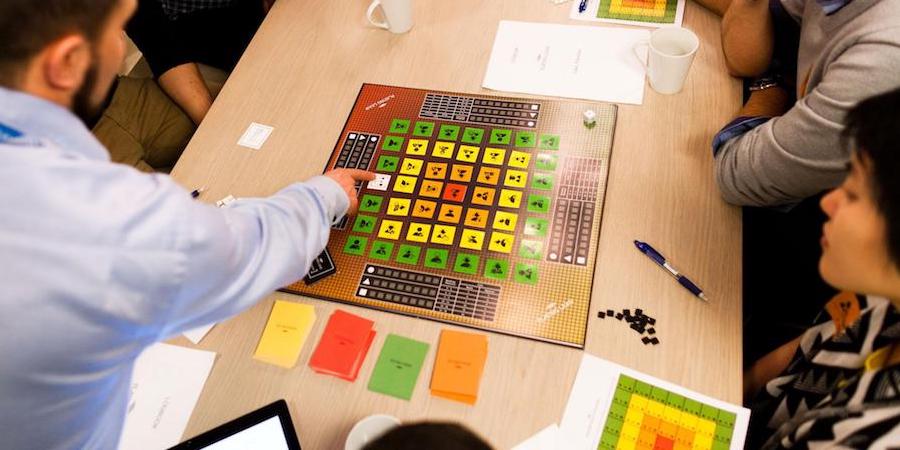
Boosting the lean-agile maturity of our teams
FEATURE – BRQ Digital Solutions shows that effective customer-focused improvement must happen from the inside out, with team development aligned with the pillars of lean digital transformation.
Words: Cristiano Burg with Erasto Meneses, Fábio Trierveiler and Carlos Baldissera
In 2019, the BRQ team embraced agile by introducing the concept of squads with the help of an agilist. The initial model was focused on converting teams, but it didn’t consider the engineering impact nor did it use lean. For a year, this practice ran with some adaptations, but always building on an exclusively agile foundation.
The following year, BRQ made changes to its working method, with the aim of developing a pillar dedicated to Lean Thinking without putting aside agility and engineering. In other words, they began implementing a lean-agile method. The first step was building a diagnostic process to get a clear picture of the current state. An evaluation was carried out with the teams, using Google Forms, but duplicate answers and other problems affected the efficiency of the process. Besides, this application of that assessment alone didn’t guarantee any evolution.
The next step was to focus on mentoring for the optimization of the company’s own framework, creating agreements with the governance competence centers that would support the lean-agile pillars with the teams. From there, a follow-up action plan was developed, running on PDCA cycles (Plan, Do, Check, Act), to continuously evolve and improve its maturity.
On a second assessment, the model still had problems: as the questions were unclear, few changes followed. As a result, there was a delay in the organization, capture and dissemination of results.
Faced with this challenge and aiming to strengthen the partnership with the Lean Institute Brasil, BRQ invited the institute to support the consolidation of lean-agile governance in the company and help it develop high-performing teams. For this, a culture that promoted fast and effective problem solving, in addition to the continuous delivery of value to their customers, was necessary.
Thus, in June 2021, BRQ started to develop its newest working model based on Lean Institute Brasil’s Lean Digital Transformation Model (LDTM), adapting it to its reality. This way, it sought to ensure better-structured pillars, with a special focus on strengthening engineering and making practices and internal evolution customer-centric.
The LDTM, inspired by the Lean Transformation Framework, is a maturity model that helps an organization’s teams to deepen their understanding of lean, agile and good practices in the use of digital technologies.
A NEW MODEL IN ACTION
The BRQ Framework consists of three pillars: Lean Management, Software Engineering, and Agility. To incorporate it into BRQ’s daily activities, the teams focused on four essential aspects of the transformation: cultural, organizational, technical, and business.
During the cultural transformation of the company, employees had the opportunity to learn about some essential concepts of Lean Thinking, such as kata (culture of continuous improvement), kaizen (problem solving method), lean leadership, and digital lean. On the organizational side, the focus was on mapping the value stream, A3 process, scrum and kanban. As for the technical part, topics such as software engineering and technical leadership were addressed. Finally, the teams also learned about lean innovation and lean-agile strategic planning (OKRs and hoshin kanri).
After several tests, they concluded that the most efficient approach is the gamification of the maturity evolution process supported by the framework. The framework is a powerful tool for the evolution of teams. In practice, it works as a PDCA guide, in which teams find a path to continuously evolve. It also supports professional development, as people can use the practices as a reference on which topics they can seek knowledge on and evolve.
BRQ AFTER THE IMPLEMENTATION
BRQ was working on bringing together lean and agile ever before implementing the framework. However, the new way of working helped the company to accelerate the evolution of its teams. People could see gaps hindering their projects much more rapidly and act swiftly to address problems and eliminate waste.
More agile and leaner, the new framework ensures better integration of the BRQ teams with client teams, increasing the quality and productivity of deliveries and, more importantly, generating more value for the final user. Talking about problems and solving them quickly – the true essence of Lean Thinking – was critical in improving team performance. Today, with the use of the framework permeating the entire organization, all clients can perceive the benefits of the new model.
With the application of the LDTM, BRQ performs three types of follow-up:
- Monitoring the evolution by making improvement cycles (every three or six months) with the application of the same diagnosis/assessment to compare current state with previous state.
- Monitoring the implementation of action plans through daily/weekly management with the support of leaders, coordinators, agile coaches, etc. as people responsible for updating this information in a virtual obeya.
- Monitoring of performance/business indicators (previously established) that show the impact of adopting the new practices on the client and BRQ's business.
For our customers, this is a way of materializing together what the steps are to deliver more and more value. We have excellent examples in-house of how the union between the maturity model, professional evolution and customer participation generated great results in the performance indicators of the squads.
Such results include a 324% increase in throughput in six months, a 37% reduction in lead-time in three months, and a 73% boost in productivity in six months.
Commenting on the 97% increase in the teams’ maturity index in just three months, CEO Benjamin Quadros said: “All BRQ teams had their own way of working, and no clear direction in the evolution of good practices. The framework aligned the teams to seek the achievement of high maturity, evolving the way we deliver value to our customers and how BRQ seeks to consolidate in the market. With a single model permeating the entire company, we were able to better track our problems, identify supporting metrics and effectively start executing a huge internal change that begins to reflect itself in customer feedback.”
As we look ahead, we know that success with gradually come as we continue developing our continuous improvement mindset with a focus on delivering value to customers. We also know that the framework we use will continue to evolve as our needs and circumstances change. This is an evolving working system that will ensure the sustainability of our business.
THE AUTHORS




Read more


FEATURE – The author discusses how the daily practice of lean thinking develops perseverance and the grit a leader needs to improve an organization.


FEATURE – Simulations and games can be extremely beneficial, so long as we use them to highlight and explain the underlying behaviors we must adopt if we are to successfully embrace lean... and not only the tools.


INTERVIEW – Overburdened and worn out? Visualizing your tasks using Personal Kanban can help you make sense of a busy schedule and reduce your stress, says Jim Benson.


NOTES FROM THE GEMBA – How do you kick off a lean journey? This French company has chosen to begin by analyzing and tackling each customer complaint.

